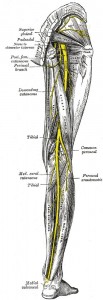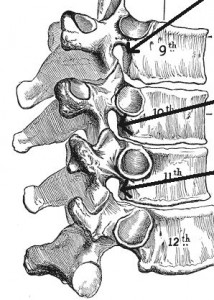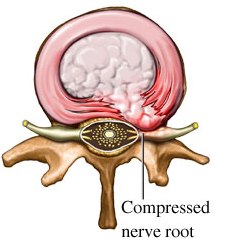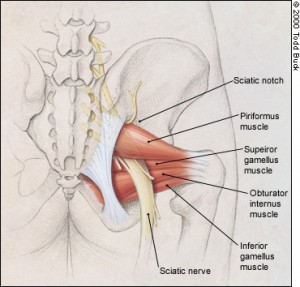Sciatic Nerve Pain
One of the most misunderstood subsets of low back pain is sciatic nerve pain, which is pain shooting down the back of the leg from the lower back or gluteal region. In this article, we’ll cover how to know if it is indeed sciatica (another term for this sort of radiating pain) or another pain syndrome, what causes it, and how to deal with it.
Sciatic Nerve Pain Defined
First off, we need to know if it’s even sciatic nerve pain at all. Sciatica is one of the most mis-used and over-utilized terms when it comes to lower back pain, so let’s be clear on exactly what it is. Sciatica is an inflammation or irritation of the sciatic nerve, the major nerve of the leg. It causes pain, numbness, or similar neurological symptoms that travel from the lower back or particularly the gluteal region down the center of the back of the leg. It can travel all the way down to the foot in severe cases, and ranges in intensity from annoying to downright crippling.
There are other nerves that go into the leg aside from the sciatic nerve, and these nerves can be irritated as well, creating similar symptoms. However, this is not true sciatica. It’s only sciatica if the nerve involved is… you guessed it… the sciatic nerve. Any other irritated nerve causing pain into, say, the side or front of the thigh is a different condition.
The sciatic nerve is a big, big nerve; the thickest nerve in the body, actually. It’s about as thick as one of your fingers. Like most major nerves, it’s really a bundle of wires, a collection of many individual nerve fibers that travel together and then split off to go their seperate ways as they reach their specific destination. It starts as a series of smaller nerves that come off of the lower spine, leave the spinal cord through little holes called intervertebral foramen (not an important term; it just means “little holes between the verbetra”, literally), then those smaller nerves join together to form the big sciatic nerve like streams joining to form a large river.
What Causes Sciatica?
All right, now that we know that sciatica is only radiating pain going down the center of the back of the leg, just what the heck causes it? There’s a number of possibilities, but I’ll break them down for you as simply as possible. Basically, you can irritate this nerve like most other peripheral nerves, by either:
1. Entrapping it at the point where it leaves the spinal column (that’s that intervertebral foramen thing I mentioned earlier), or
2. By entrapping or pressing up against it with one of the supporting muscles of the spine or pelvis.
Let’s do the first one first.
Sciatica By IVF Compression
Remember, I said this nerve begins by coming off the spine and emerging out of the bony protection of the spinal column through small holes between the vertebra called intervertebral foramen. Normally, there’s plenty of room for the nerve to fit through the hole, but different conditions can reduce the size of that hole and therefore press on the nerve.
The major causes of IVF (intervertebral foramen) encroachment– or narrowing of the nerve hole in layman’s terms- are arthritis and disc bulges. By arthritis, I mean osteoarthritis or DJD, the wear-and-tear kind of arthritis. Over time and with repeated stress, the disc wears out, becomes thinner and drier, and shrinks in height. This lowers the top vertebra closer to the bottom one, and that reduces the size of the hole the nerve can pass through. Eventually…. squish goes the nerve.
Alternatively, a person can injure the disc in such a way as so cause it to bulge out in one direction or another. This is often erroneously called a “slipped disc“, but nothing is slipping.
The disc has a gushy, mushy center core, like the middle of a jelly donut. That jelly-like stuff is surrounded by a series of tough concentric rings that look like the rings of a tree that’s been sawn in two. Through trauma (either violent single trauma or repetitive microtrauma), those rings can get little tears in them, weaking them enough that the jelly-like stuff can push out through the weakened portion, bulging out a portion of the disc. In REALLY bad cases, the outer rings will tear all the way through and allow the jelly to leak out. This is called a sequestered fragment and pretty much is a disaster situation requiring surgery.
The bulge can go in any direction; towards the front of the body, the back, or off to the sides. If that bulge happens to go in just the right spot, it can push against the nerve root as it tries to travel out of the spinal column (the IVF). Once again, squish goes the nerve, and that compression causes irritation, numbness, and the radiating pain associated with sciatica.
By the way, you can get a combo package, too. It’s not uncommon for people with weak, thinned discs from arthritis to experience a disc bulge as well.
These conditions are a bugger to deal with. But it’s not always a disc problem.
Sciatic Nerve Pain From Piriformis Syndrome
After the nerve makes it through its little hole in the spinal column, it still has a long way to travel before it gets where it’s going. Along the way, it can become entrapped and compressed by any number of muscles or other structures.
In the case of sciatica, we’re usually talking about one muscle in particular, the piriformis, although there can be other culprits. It’s usually the piriformis, though; in fact, this is so common that there’s even a term for it: piriformis syndrome.
The piriformis is a rectangular shaped muscle deep in the pelvis. It goes from the middle of the pelvis out to the hip joint, and technically acts as an external rotator of the hip. That just means it twists your leg outwards like you want to point your toe out to the side, pivoting on your heel.
Really, though, it supports your pelvis in the opposite direction. Whatever. The reason why we care about the piriformis in this case, is that the sciatic nerve goes right underneath it. Well, in most people. In around ten percent of the population, the nerve goes right through it. Needless to say, it’s a little more likely for those people to have issues with entrapment of the sciatic nerve by that muscle.
Even for those ninety percent whose sciatic nerve goes under rather than through the piriformis can still have trouble with piriformis syndrome. A spastic or lax piriformis can compress the sciatic nerve and cause those classic shooting pains down the back of the leg.
Similar problems can occur with nerves coming off of the spine getting entrapped by one of the many supporting muscles of the spine itself (usually collectively referred to as the paraspinal muscles). These kinds of radiating pain are similar to sciatica, but are not classic sciatica, so we will not go into them in detail.
Now What?
Obviously, the treatment for sciatic nerve pain is going to depend on the cause. It’s not going to do you much good to undergo therpy to treat the piriformis if your sciatica is being caused by a big ol’ disc bulge pressing against your nerve.
Before I start, I should probably fire off this quick disclaimer. I certainly cannot diagnose you or recommend any course of action for your particular situation via the internet. But I can give you some idea as to what sorts of treatments are out there.
For IVF compression, a common therapy to repair the disc is spinal decompression, which is a form of traction. Patients often joke that it looks like they’re on the old mideval “rack”. By stretching the spine axially (lengthwise or top to bottom), the disc material is drawn back in through the torn circular fibers, allowing those fibers (hopefully) to heal.
For piriformis syndrome, there’s a number of different therapies used to try to restore the piriformis to its natural state and put a stop to it compressing the sciatic nerve. They’re difficult to describe in text. I use a technique in my office in which I pick up the affected leg while the patient lies face down and turn it passively through that external motion that the pirifomis is responsible for. There’s a bit more to it than that, but that at least gives you an idea of what this sort of treatment looks like. It usually involves some sort of stretching motions in an attempt to normalize the piriformis.
All right, I hope this gives you a better idea of what you’re dealing with when it comes to sciatic nerve pain. Take this information with you when you go to see your health care provider so you can most effectively plan a solution. Most sciatica is manageable without surgery, but be sure to consult with your doctor to get enough information to take the next step.
Questions? Comments? Feel free to leave them below! Stay healthy!





[…] If the symptoms don’t travel along this course, it’s not sciatic nerve pain. True sciatica is very often mistaken for an irritation of one of the other many nerves of the leg. That kind of pain is not true sciatic nerve pain. […]
[…] If the pain doesn’t follow this track, it’s not sciatic nerve pain. True sciatica is very often mistaken for an irritation of any one of the other many nerves in the leg. This is not true sciatic nerve pain. […]
[…] Any shooting pain different than what was just described is another problem. Real sciatic nerve pain is very often misdiagnosed as an irritation of one of the other nerves in the leg. That kind of pain is not true sciatic nerve pain. […]
[…] If the symptoms don’t travel along this course, the condition is not sciatica. Real sciatica is very often misdiagnosed as an irritation of one of the other many nerves in the leg. This is not true sciatic nerve pain. […]
[…] If it doesn’t travel along this area, the condition is not sciatica. The other nerves of the leg can be irritated and cause radiating pain, but pain going down the rear of the leg is real sciatic nerve pain. […]
[…] If it doesn’t travel along this course, the condition is not sciatica. Other nerves in the leg can be irritated and cause radiating pain, but pain down the rear of the leg is real sciatic nerve pain. […]
[…] Any shooting pain different than what was just described is another problem. True sciatica is very often mistaken for an irritation of one of the other nerves in the leg. That kind of pain is not true sciatic nerve pain. […]
[…] Any shooting pain different than what was just described is another problem. Any of the other nerves of the leg can be compressed and cause shooting pain, but only pain down the back of the leg is true sciatic nerve pain. […]